Pesticide Usage in Scotland: Protected Edible Crops 2015 - Summary Report
Report on a survey of pesticide use on protected edible crops in Scotland.
This document is part of a collection
General trends
Some trends relating to crop area and total pesticide use are discussed below. However, it should be noted that the protected edible survey is the smallest in the series of pesticide usage surveys conducted by the Pesticide Survey Unit. The area of protected edible crops grown (excluding soft fruit) in Scotland is very small in comparison to other agricultural and horticultural crop groups. In addition, the large range of crops encountered, which have markedly different pesticide use, as well as the use of multi-cropping, all combine to make this report more complex and the estimates less robust than other reports in this series. Because of these factors, this summary report does not break estimates down into different crops and caution must be applied when looking at trends in the data as it is not possible to assess to what extent trends are influenced by differences in the crop types encountered in the sample. This uncertainty is reflected in the large relative standard errors associated with these estimates ( RSE 89 and 86 per cent for area and weight respectively, Table 17).
Crop area
The land area used for growing protected edible crops recorded in the June Agricultural Census decreased by 24 per cent from approximately 15 hectares in 2013 to 11 hectares in 2015 ( Table 12). However, the estimated crop area grown in Scotland in 2015 was just over 31 hectares, including multi-cropping, representing a 46 per cent increase since the previous survey in 2013 ( Table 11, Figure 1). This indicates that more multi-cropping was recorded in 2015 than in the previous survey. The estimated area which was multi-cropped almost trebled between 2013 and 2015. However, this may be due to the type of crops encountered in the sample rather than solely representing an increase in the multi-cropped area overall. The area of salad crops encountered in 2015 was four times higher than in 2013, which are more routinely multi-cropped than other crop types. There are a large range of crop types grown under protection and the crops encountered vary from survey to survey depending on the sample composition.
Figure 1 Estimated area of protected edible crops grown in Scotland 2011-2015
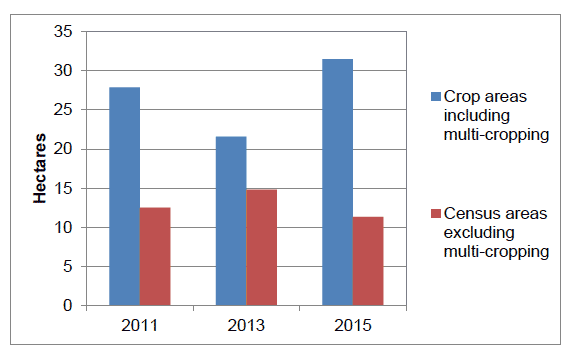
Pesticide usage
It is estimated that almost 40 per cent of the 2015 protected edible crop was treated with a pesticide, the same as recorded in 2013 ( Table 1). The treated area on average received 1.3 applications of pesticide (excluding seed treatments, Figure 6). Despite a similar proportion of crop being treated the estimated area of pesticide formulations applied decreased by over 80 per cent to just under 20 hectares in 2015, indicating that the treated area received fewer applications in 2015 compared with 2013. Due to the aforementioned issues with the wide range of crops grown under protection and differences in the crops encountered among surveys, the differences in pesticide use detected are likely to have been influenced by sample composition rather than solely reflecting changes in pesticide usage pattern. For example, the use of fungicides and sulphur (which was used for the control of powdery mildew) decreased by 89 per cent in 2015 compared with the previous two surveys ( Figure 2). The use of fungicides in 2013 and 2011 were mainly recorded on micro-propagated potatoes which are sprayed with multiple applications of fungicides for the control of blight. In contrast to previous years, no micro-propagated potatoes were encountered during the 2015 survey. The area treated with biological control agents more than doubled from just under two hectares in 2013 to just over four hectares in 2015. This may also be the result of sample composition as biologicals are more likely to be used on salad and vegetable crops than on micro-propagated potatoes.
Overall the estimated quantity of pesticides applied per hectare has declined over the last three surveys. Average application rates declined from just over 16 kg/ha in 2011 to just under 8 kg/ha in 2013 ( Figure 4). This then fell to less than 0.1 kg/ha in 2015. The decline between 2011 and 2013 was primarily driven by the reduction in the usage of soil sterilants which were applied at high dose rates ( Figure 3). The reduction in quantity applied between 2013 and 2015 was mainly due to a decrease in the usage of most pesticide groups, particularly fungicides. As discussed previously, this is likely to be the result of the sample composition rather than representing a real change in pesticide usage pattern in protected crop cultivation.
Information on the timings of pesticide applications to protected crops is included for the first time in this report ( Figure 5). Most applications were recorded in late spring in March and April with the exception of herbicides which were applied in October and disinfectants which were applied during the winter months. The area treated with disinfectants decreased by 74 per cent from ca. 13 hectares in 2013 to ca. three hectares in 2015. Disinfectants are not pesticides and are not applied directly to the crop themselves but are applied to the fabric of the tunnels/glasshouses as washes or to sterilise equipment.
In terms of area treated, sulphur was the most commonly used active substance, followed by the seed treatment metalaxyl-M and the insecticide spinosad ( Table 8). Sulphur was also the most commonly used active substance by weight ( Table 9). Sulphur was primarily used as a fungicide for the control of powdery mildew.
A number of active substances were encountered for the first time on protected edible crops in 2015. These included the fungicide copper sulphate and two biological control agents (parasitic wasps and the nematode Steinernema carpocapsae) ( Table 10).
Figure 2 Area of protected edible crops treated with the major pesticide groups 2011-2015
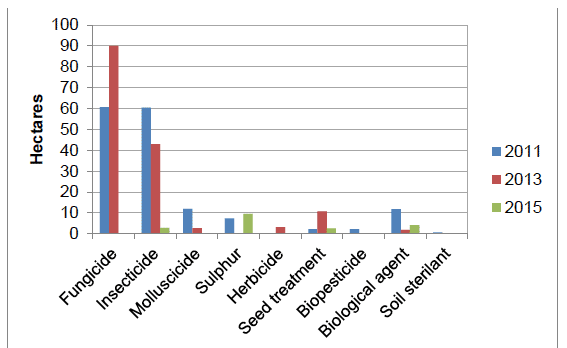
Note: see appendix 3 - definitions for differences between biopesticide and biological control agent.
Figure 3 Weight of the major pesticide groups applied to protected edible crops in Scotland 2011-2015
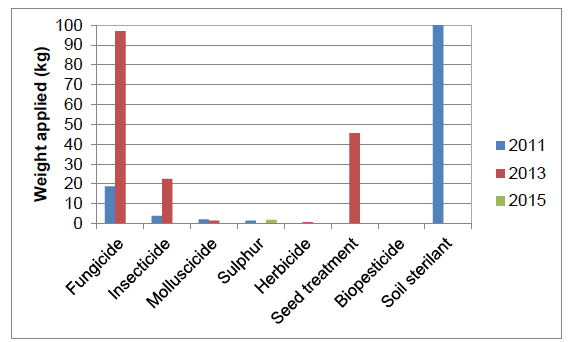
Note: As it is not always possible to collect rates for biological control agents, their quantities are unknown and are therefore not included in the graph above.
Figure 4 Weight of pesticide (kg) applied per hectare of crop grown
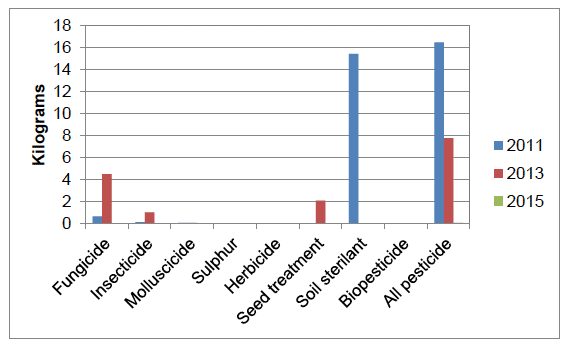
Note: Biological control agents are applied by number of organisms rather than weight therefore data are not included in the graph above.
Figure 5 Timing of pesticide applications to protected edible crops Oct 2014 - Sep 2015
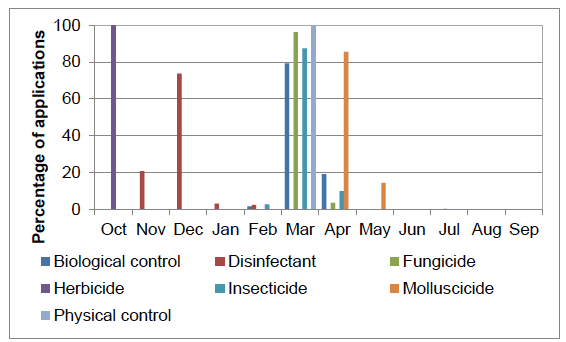
Note: Biological control includes both biopesticides and biological control agents
Figure 6 Average number of applications made to protected edible crops excluding seed treatments (% of crop treated)
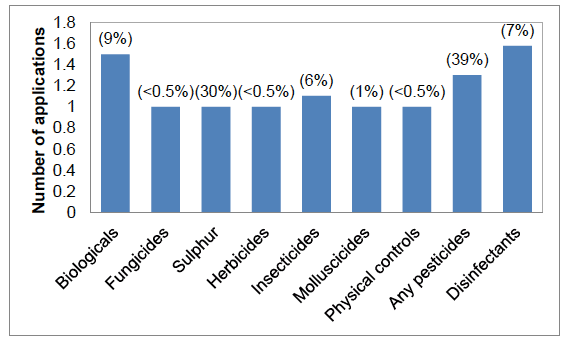
Note: Biological control includes both biopesticides and biological control agents
The average number of applications is calculated only on the areas using each pesticide group and therefore the minimum number of applications is always going to be one.
Integrated Pest Management
For the first time in this series of surveys, additional data collection was conducted in relation to grower adoption of Integrated Pest Management ( IPM) measures (see Appendix 6 for full details). The term 'pest' is used to denote diseases, weeds and pests. Unlike the other statistics in this report, the figures relating to IPM are not raised ( i.e. are not national estimates) but represent only the responses of those surveyed.
In total IPM data was collected from 15 holdings, representing 87 per cent of the sampled crop area and 15 per cent of the total crop area. Of these growers, 13 per cent had completed an IPM plan for their crops ( Figure 10). Growers were asked about their IPM activities in relation to three categories; risk management, pest monitoring and pest control. Despite the low level of IPM plan completion the growers surveyed adopted a range of IPM activities during their crop production.
A number of risk management measures were adopted by the growers surveyed ( Table 18). Two thirds of growers used crop rotation to manage the risk of pest damage. A similar proportion (60 per cent) of growers tested their soils in order to tailor inputs to improve crop performance. Almost three quarters of growers managed their seed bed production to reduce risk and a similar number amended cultivation methods at sowing. Almost two thirds of the growers surveyed also considered risk management when selecting seeds and/or varieties and almost half of respondents sowed catch or cover crops as part of their crop production cycle. Finally, 60 per cent of the growers sampled adopted techniques to protect or enhance populations of beneficial insects.
A number of pest monitoring activities were recorded ( Table 19). Sixty seven per cent of growers regularly monitored crop growth stages and 73 per cent monitored and identified pests on their crops. In addition, some growers (13 per cent) used specialist diagnostic testing for pests that are more problematic to identify or monitor.
The majority of growers (80 per cent) used non-chemical control in partnership or instead of chemical control ( Table 20). A range of control methods were adopted, including use of biological control and physical/mechanical control measures ( Figure 18). Forty per cent of growers stated that they targeted their pesticide applications using monitoring data. In addition, 27 per cent of growers stated that they followed anti-resistance strategies. Finally the majority of growers (80 per cent) stated that they monitored the success of their crop protection measures.
Contact
There is a problem
Thanks for your feedback